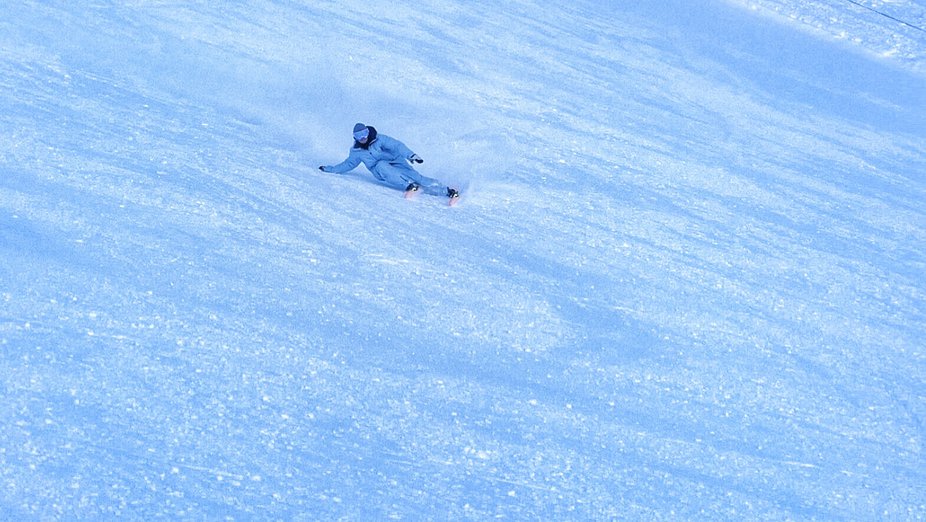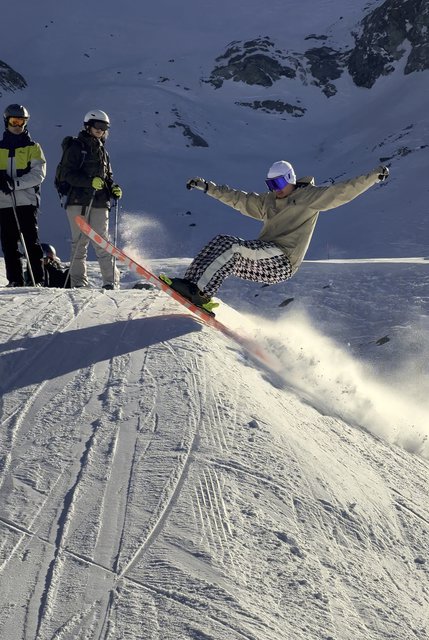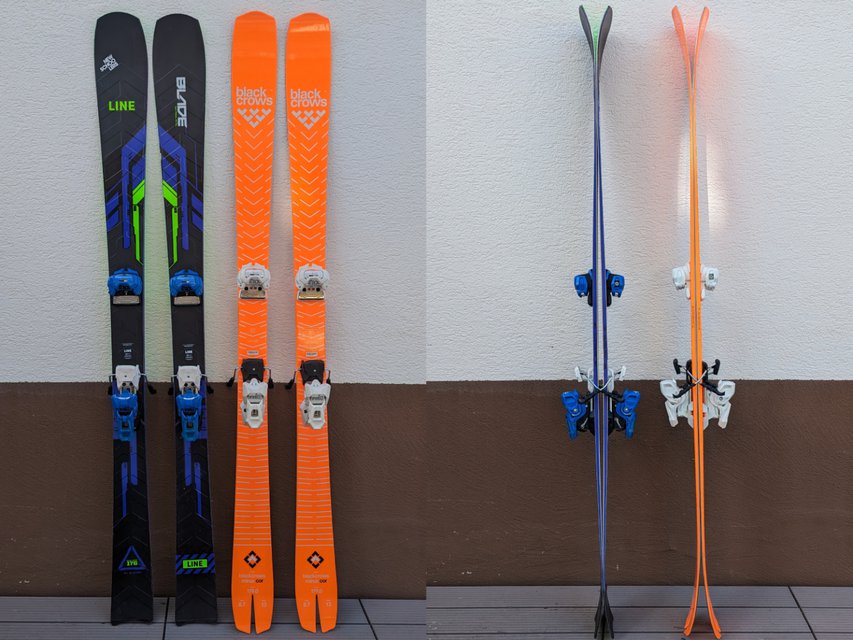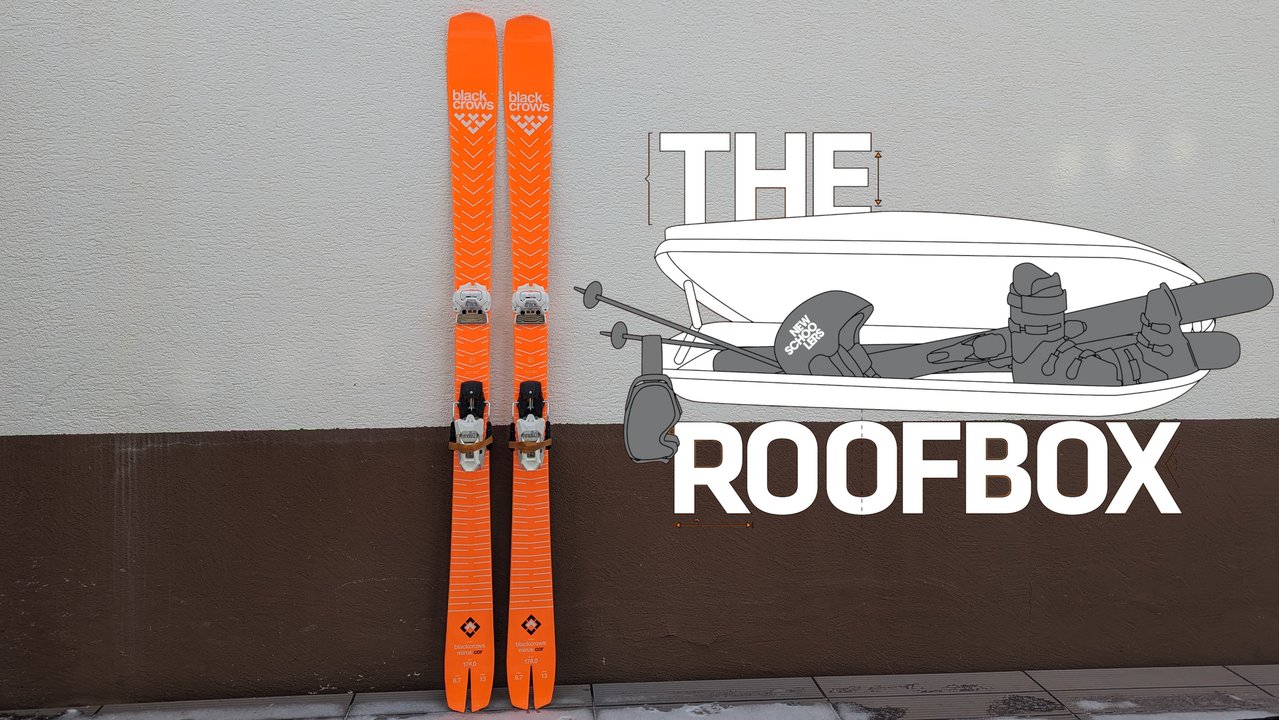Ski: Black Crows Mirus Cor
Reviewer height/weight: 5’9, 145lbs
Ski weights (per ski): 1882 & 1895g
Length skied: 178
Actual length (with straight tape): 176.3
Dimensions: 134-87-123
Mounted: -2.75 cm from true center
Bindings: Tyrolia Attack 17
Locations: Saas-Fee
Conditions skied: Park, icy slopes, corduroy, slush (depressingly for mid-winter)
Days Skied: 10
_
The Mirus Cor is slowly but surely taking over Europe. You see more and more of this highlighter orange frankenski as the seasons since its release pass. And there is a good reason for that. The past two winters over here have been, quite frankly, shit. Yes, there have been storms here and there (although sadly, not so much of the ‘here’) but put it this way, on paper, an 87mm underfoot carving-oriented fun stick pretty much ticks all the boxes for the conditions we’ve had. I’ve been waiting some time to review these so I was stoked when they finally showed up.
_
Shape/Flex/Construction:
The construction of the Mirus Cor isn’t too different from much of what is on the market these days, with the exception of a single sheet of titanal in the center of the ski which isn’t something commonly found on freestyle-focused skis. That aside, they feature a full wood core, a full-length sidewall, and a small microcap topsheet.

The shape and flex are where these skis get interesting. Shape-wise, the tight radius is the headline act, 13m is seriously small for anything that isn’t hitting slalom gates. The tips and tails feature early taper and the shovel in particular looks, well, like a shovel. The tail has that mini-fishtail which is very much for show only.
Most unusual of all though are the profile and flex of these skis. They do have metal but you don’t really feel it. To me, the flex feels pretty consistent through the ski, maybe 5-6/10 all throughout. That means they are pretty soft underfoot, relatively speaking which is nice in a turn, but they aren’t the most stable. The profile is also pretty playful, with significant rocker tip and tail and (initially) a smidge of camber. The skis were basically flat underfoot after two days and you can see the profile after 10 days of riding in the photos.
_
On snow:
Pow, crud, mixed snow:
With this review, I figured it made sense to get this category out of the way first. At 87mm underfoot, this is not a pow ski, it’s not even close. The tips are pretty fat and there’s some rocker, so they handle a dusting of soft snow better than a stiff, center-mounted twin but that’s about the end of it. They are on the soft side when dealing with any kind of refrozen or cut-up snow. There’s a little backbone underfoot but it’s not nearly enough to push through mixed conditions and they are a lively, snappy feeling ski overall, which translates to, they deflect a lot. The thing that they are pretty fun for is slush. Here the rocker comes into its own and they cut through consistently slushy inbounds conditions nicely. But these are fundamentally not all-mountain skis. They are for groomers and that is where they need to shine.
_
Groomers:
And to a large degree, shine they do. It has been years since I skied a true slalom ski and with luck, it will be years until I do again. They are too aggressive for my somewhat (read very) lazy style of skiing. They are fun for about a run and half, but after that I find them more stressful than enjoyable. The Mirus Cor offers a huge percentage of the fun, but without the sting in the tail, so to speak. With a ~13m nominal radius and a relatively soft flex, you can bend these into the tightest of turns. I didn’t do the best job of stacking media on these guys but I found it was incredibly easy to crank turns, get my full forearm down on the floor and laydown carve. You can circle carve with ease.

Short turns are made ridiculously easy too and if you apply a light touch, they don’t feel so aggressive that you cannot cruise longer radius turns too. And unlike a slalom ski, it’s super easy to break the turn loose, go sideways, slash the tails etc. The lack of camber underfoot and the fairly generous rocker makes entry and exit of turns a breeze. You can do things that on a slalom ski would pitch you 15ft to your collarbone real quick. There is nothing like the energy from turn to turn of a ski with a ton of camber but here, the nigh flat underfoot section works in harmony with the radius to provide a ski that balances being aggressively turny but not aggressively… aggressive very well.
Nitpicking, I have a couple of small gripes here and they are related. Firstly, while the edge hold is spectacular, these skis are pretty soft throughout. While they do grip on ice, if you try to drive the tip too much, it doesn't want to hold an edge, which means skiing with a centered stance is basically required. That suits me, because I do so naturally anyway, but I suspect many of the people looking for this kind of ski would like a ski they can drive harder. Or maybe they just think they would which is why they are so popular.
The soft flex is also a twofold issue because in making a playful, short radius ‘fun carver’ Black Crows have gone with a near-true twin rocker profile. There are huge benefits for that (see Park/Jibbing) but there is almost as much rocker in the tail as the tip, and the flex feels fairly symmetrical around the mounting points too. The result? The tail is, in my opinion, too soft and too rockered. When driving these as hard as I could, I had some issues with the tail of the ski washing out as I passed the nexus of the turn. Please note, this is a relative point. These skis blow anything you would normally ski as a jib ski out of the water when it comes to laying down short radius turns, it’s just that when I really started trying to push them, I found myself wishing for a bit more backbone.
_
Park/Jibbing:
However, that balanced shape and near symmetrical rocker profile, along with a recommended mounting point of -3.75 (I bumped forward to -2.75), gives you a ski that is properly capable on jumps up to say 40ft. If you're a great skier you could go bigger, it's just not the most stable ski. They feel pretty balanced in the air, and despite some metal underfoot, aren’t too jarring on landings. They aren’t quite 'park ski comfortable' on landings, you can feel the metal, but they are close enough that for most tricks, I didn’t notice much difference. To me, the only real change was slightly less comfortable absorption of transitions and the swingweight not being as balanced and light as a true park ski. It’s about equivalent to a mid-fat ski like a Reckoner 102 or similar.
For jibbing around though these are a ton of fun. They have one of the most striking combinations of soft flex and plenty of rocker, while at the same time being very energetic, that I can think of. If you load up the tails, they ping you back better than almost any ski I can think of... similar to the Armada Stranger perhaps. They will slash and cut loose whenever you want them to and the rocker gives them forgiveness that no other groomer-oriented ski has for sidehits and transitions.

They butter easily enough, although for me, they have perhaps a bit too much snap when exiting butters, making controlling direction and holding presses less fun than some skis, the K2 Poacher and the new Line Chronic both feel better for that, as two examples. But for a ski that turns this well to be buttery at all is impressive. The -3 mount point is close enough to center to be balanced enough on rails, but I think I only hit two because the whole point of this ski is turning, and that requires edges (and therein lies a conundrum for NSers).
_
Other notes (Durability/Length/Mounting point):
I don’t have anything much to say about the durability of the Mirus Cor because I only hit a couple of rails and then skied groomers. Of course, they held up to that just fine. I did some buttering and hit some jumps and there is no sign of any delamination, but nor would I expect there to be with how I mostly skied these.
Something I did want to bring up was length and mounting point. These skis are one of those skis that the brand suggests you might want to size down with. Don't. Get your normal size. I rode 178, which is my normal size park ski and I wouldn’t even consider sizing down. If anything, I’d be tempted to try a 184 to get a little more stability.
I mounted the Mirus Cor 1cm in front of the recommended line and they still railed. I naturally ski fairly centered after more than a decade of center-mounted skis and I feel like that worked well for me. I don’t see why you couldn’t center-mount these, but I also don’t really see why you would because skiing rails would kind of defeat the point of the ski. But even with the short radius +/- 1.5 of the recommended line would certainly feel fine. If you want to ski park, I’d recommend bumping forward a bit to gain some tail stability. If you really like to drive the tip, you could go a smidge back from recommended.
_
Comparison VS Line Blade: The Showdown
In reality, there is only one ski that occupies vaguely the same market space as the Mirus Cor, and it’s the Line Blade. The Stranger is much wider and less nimble and no other park ski has this kind of groomer performance. Lined up next to each other, the Blade and the Mirus look VERY different, but they serve a similar purpose, turn-oriented skis that you can still play around on. They approach the problem of a playful carving ski in slightly different ways but they are essentially targeting a similar consumer. This will be my only comparison here and I skied these skis back to back for about three weeks, so I hope this extended comparison section is useful.

Side by side. The Blade does plenty of things well, but it doesn't stand up straight...
It’s worth noting that in their initial marketing, Black Crows actually called out the Blade:
“The [Line] Blade is wider, everything is magnified, and more lumbering, it's heavier underfoot. It’s not a responsive ski and doesn’t have the panache or desire to perform like the Mirus, whose limits are only down to the fact it’s also a freestyle ski.”
There is some truth in that, but it’s also a biased take. Yes, the Blade IS damper and slower edge-to-edge than the Mirus, but I would argue it’s both smoother and more versatile as a result. It’s much better in soft snow, much better in mixed conditions, and perhaps more importantly it offers a much smoother ride over a bigger variety of turn shapes. The tail on the Blade is more stable, and overall, I actually felt like the Blade was the better ski on groomed snow, except for in extremely icy conditions where the narrower Mirus had more grip. The Blade also has a significantly higher speed limit in my books and feels more in control when flat base pointing it.
However, the Mirus IS more of a freestyle ski than the Blade. But taking rails out of the equation, where I find a balanced shape matters more than on jumps, the advantage is less stark than it would appear looking at the two skis. The Blade does just fine for basic park laps, and mounted at -4cm it felt fine on jumps for 1s and 3s. It had more pop on jumps than the Mirus Cor too, thanks to the camber but the swingweight is noticeably higher.
The main aspect in which the Mirus blows the Blade away is skiing switch (for lesser mortals than Dylan Siggers, the Blade has a definitively directional shape). The Mirus Cor’s added tail rocker and more symmetrical shape make switch riding and particularly switch takeoffs, much more comfortable. You can also land switch in tight transitions on the Mirus just fine, whereas the Blade is less of a twin and so I’d have hang-up-related concerns. I found the Blade perfectly good for landing switch on regular jumps but a key difference was switch takeoffs, which I found somewhat terrifying on the Blade but a semi-normal feeling on the Mirus Cor. I did find BOTH skis to have too tight a turning radius to be comfortable straightlining switch into jumps but overall, the Mirus IS a better ski in the park.
As much from curiosity as anything, I gave both skis to my good friend Ivan to try too. He’s a ski instructor and a gnarly freerider, but also a very solid park skier, and a much more technically trained skier than me. Hopefully, his feedback will be featured in more of these reviews in the future. He found the tip engaged a little more naturally on the Mirus and provided more feedback/sensitivity. Given that the tip on the Blade is ridiculously wide, that isn’t entirely surprising. The Blade doesn’t grip as well as the Mirus up front and for a performance ski, the Mirus is already a little loose when pushed. But we both agreed the Blade was much more solid through the second half of the turn and it skied a wider variety of turn shapes with more power than the Mirus.
To my surprise, given that he is a more traditional skier overall than me, he came away preferring the Mirus for his uses, where I preferred the Blade. It’s worth factoring in that most of his quiver is either race or freeride skis, whereas mine are almost all jibby, softer skis. So I was subconsciously looking for a more all-mountain/groomer performance ski, and he wanted a fun ski he could still teach on, which doubtless informed our preferences.
For me, choosing between these two, comes down to how much jibbing you’re going to do, how hard you want to push the skis and where you are based. If you want to ski more than 40% park or you want to spin fast, or you mostly ski consistent hardpack conditions then I would probably pick the Mirus Cor over the Blade. It is a better park ski and has a little more energy (if you ski more than 60% park, then you want a proper park ski btw). But if you are only spinning up to fives and you want to spend some time venturing all over the hill, while still getting ‘ass to grass’ the Blade has a lot to offer you there. I found the dampness of the Blade to be more predictable and that it could take being pushed harder. Plus it’s a lot better in soft snow and in mixed conditions. There isn’t a right answer here, you just have to consider your preferences.
_
Conclusion:
In short, the Mirus Cor is a very unique ski. With a -3.75 mounting point, and no issues bumping that a little forward, these orange frankenskis are pretty much the only ski out there that is truly focused on both freestyle and turning. As mentioned above, the Line Blade is the closest comparison but, no two ways about it, the Blade is a more directional ski. So if you basically want a 50/50 groomer and park ski, it’s hard to look elsewhere. But be honest with yourself, because if you actually want a groomer/all-mountain resort ski that occasionally you ski some basic park laps on, the Blade is right back in the equation.
Usually, in these reviews, I end up suggesting a lot of different potential uses for a ski in the conclusion but the Mirus Cor really only has one. It’s a freestyle ski with exceptional turning powers. There is simply no other ski this comfortable in the park that you can lay these kinds of turns on. Hopefully, we’ll see more of these kinds of skis in the future because they are an absolute riot, but for now, it’s as simple as that.


Comments